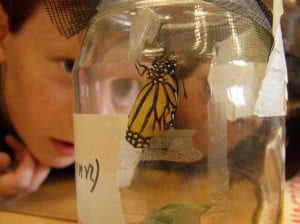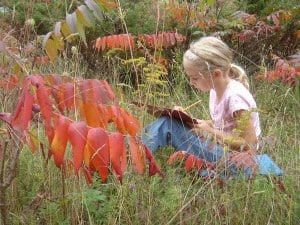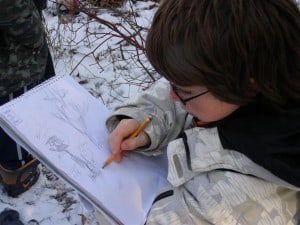“Take one child. Place outdoors in nearby green spaces. Leave for several hours at a time. Repeat daily. Sprinkle in a dash of adventure. Fold in a generous portion of exploration and discovery. Top with wonder and awe. Let rise…”
Not long ago, my friend Jacob and I took a group of children out for a hike to a nearby wetland. Along the way, we came across some Northern Leopard Frogs. “Let’s catch ‘em,” some of the boys yelled out, ready to pounce. “No,” we suggested, “let’s watch instead.” So we did. We hunkered down and stayed as still as we could. We observed how one frog hopped slowly against a backdrop of sedges and wildflowers, its spotted, wet skin glistening in the sun. We watched, too, how its pink tongue snapped out and grabbed an unsuspecting grasshopper. “Did you see that?” the kids exclaimed. “That was awesome!” And it most certainly was.
In an increasingly urbanized world, children (and many adults) experience far less contact with the natural world. Our children are far more likely to watch the flickering screen of a video game or hear the sounds of traffic than see tadpoles in a woodland pond or hear the rhythmic chorus of frogs in spring. They are also more likely to recognize hundreds of corporate logos or cartoon characters than be able to identify more than a handful of local plant and animal species.
As I have mentioned in several previous columns, I am working on a nature activity guide with Jacob Rodenburg, Executive Director of Camp Kawartha. The book calls on all of us to reclaim the natural world as an integral part of the human sphere. It also asks that we encourage our children to value nature-based experiences – the kinds of experiences in which we hear birds, feel the mud between our toes and stare in wonder at the night sky.
Just as family, friends, neighbours and colleagues form a very real community in our lives, there is also a very tangible sense of belonging and connection that arises from being immersed in nature. More than ever, children need opportunities to learn and feel that they are part of this larger community, too. And, like any relationship, this requires commitment, time and effort.
We want parents, grandparents and educators alike to think about how to raise caring, responsible and engaged citizens who recognize that their community includes both the living and the abiotic (e.g., air, water, soil) systems that support and nurture us all. While it is true that we enjoy a world of amazing technological tools from smartphones to apps of all kinds, we’d like people to think about selecting technologies that enhance outdoor learning – rather than getting in the way of it. We all need to help kids – and, increasingly, ourselves – to see the value of connecting to nature, not just to addictive screens.
In 1980, Thomas Tanner, an environmental education researcher, interviewed close to 200 professionals from around the world, who were involved in the conservation movement. He wanted to know what childhood experiences these people had had in common, which inspired them to want to protect the environment. Not surprisingly, almost all the respondents described rich encounters with nature while they were growing up. They lived on farms, they tramped through marshes, they visited cottages, they hiked, they canoed and they discovered. In short, they engaged with their natural surroundings. However, today, many of us are asking where tomorrow’s environmentalists will come from? Who will advocate for shrinking habitat and the containment of urban sprawl? Who will speak for threatened and endangered species and for our own green spaces, when the very formative experiences that make for caring environmental stewards are removed from childhood?
As a society, we pay a huge price for our disconnection from nature. The rate of childhood obesity in North America has almost tripled over the past twenty years, partly because children are spending less far less time outside and are therefore not participating in regular exercise. Research has found that children who explore and play in natural environments tend to be less competitive and more co-operative than those who play in areas dominated by asphalt and play structures. Playing in nature also enhances creative thought, stimulates imaginative play and improves a child’s ability to concentrate during school.
But nowhere is the cost of our disconnection from nature greater than when it comes to climate change. Now, more than ever, we need to be paying attention to the myriad changes – many of which are subtle – that are occurring all around us. Yes, climate change is partly about wrenching disasters, but it’s also about numerous “canary in the coal mine” events: the early arrival of migratory birds, the early blossoming of wildflowers, the increased frequency of unseasonal weather events, etc. Noticing these small changes and understanding that they represent a kind of climatic early warning system requires a critical mass of “citizen naturalists” that have first-hand, detailed knowledge of local nature and care deeply.
Overview of book
Tentatively entitled “Nature Activities through the Seasons – a guide for families, educators and youth leaders,” our book will be a collection of things to do outside over the course of an entire year. Part of the inspiration came from my 2002 book “Nature’s Year in the Kawarthas” and a desire to provide activities to accompany the many events in nature described within. Although the activities are geared mostly to children and adolescents, many will also be of interest to adults – including seniors – and to families looking for ways to enjoy nature together.
The book will be divided into four sections, which include an introduction, basic nature skills, core concepts (e.g., evolution, phenology, climate change, why we have seasons) and activities specific to each season. They include fun activities (e.g., games, arts and crafts, nature collections, scavenger hunts) as well as more serious activities such as species identification, nature photography, journaling and ways to enhance sensory awareness. The book will also strive to help children and adults alike develop a deeper understanding and appreciation for evolution in everyday plants and animals. Each season also includes activities based on “Big Ideas” that are key to acquiring nature literacy. For example, in the Fall chapter we look at the Big Idea of metamorphosis and how it can be seen and understood by raising Monarch butterflies.
Readers will also find hints on how to raise a naturalist, how to be an effective mentor to children and how to get kids outside – even in an age of busy schedules and heightened concerns for safety. The extensive skills section will provide an introduction to year-long activities such as birding, insect-watching, botanizing, reading animal tracks, geocaching for naturalists, sketching, photography, Citizen Science projects and connecting with nature in a digital age. Informative side-bars cover topics such as common misconceptions about nature, species to learn to identify each season, nature-viewing from a car, what to sketch or photograph and ideas for what to focus on during a neighbourhood walk. There is also an “At-a-glance” chart of what to look and listen for each season.
The book is being published by New Society Publishers and should be available in the spring of 2016.
Break from column
In order to devote myself more fully to this project, I have decided to take a break from this column until early next fall. I have arranged, however, for a number of very knowledgeable local naturalists and educators to fill in for me during my absence. They are:
• Martin and Kathy Parker – Martin is the president of the Peterborough Field Naturalists and, together with his wife Kathy, was a long-time nature columnist for the North Bay Nugget
• Rick Stankiewicz – past president of the Peterborough Astronomical Association and award-winning photographer
• Tim Dyson – naturalist with special expertise in moths and birds of prey
• Paul Elliott – professor in the School of Education at Trent University with a special interest in environmental education as well as bat ecology and conservation
• Jim Schaefer – professor of biology at Trent University whose lab focuses on the population ecology and conservation of northern mammals, especially Woodland Caribou. Jim has been a regular contributor to the Examiner for many years.
• Lisa Nisbet – assistant professor of psychology at Trent University whose research focuses on connectedness with nature and the links with health, well-being (happiness), and environmentally sustainable behaviour.


